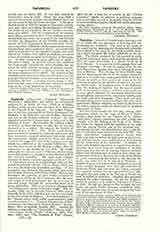

Tapestry— A word of French origin naming a fabric in which the two processes of weaving and embroidering are combined. The woof is not made in the usual way by throwing the threads with a shuttle, but is added to the warp by the aid of a needle carrying a short thread of the color called for by the desegn. The fabric produced by this method of work, in which richness of color and exquisite gradation of tints are easily obtainable, is a mosaic made up of dyed threads. It is used for wall-hangings, floor and furniture coverings. It was so employed by the ancient Egyptians, passing from them through Western Asia to Europe. Here, during the later Middle Ages and the Renaissance the art of the tipsier reached a high state of perfection, more particularly at Arras in France, so much so that arras-work came to be the common designation for all sorts of tapestry, no matter where made. In England, prior to the Reformation, the making of tapestry was the special handicraft of the monastic houses; and their arras-work was in very great demand for reredoses, altar-frontals, antependiums, hearse-cloths, sanctuary carpets, pal-ace wall and choir hangings. They were not only wrought along purely ornamental lines, but more often represented Biblical subjects, incidents in the lives of the saints, historic scenes, or illustrated by symbols some point of Faith.
Matthew Paris records the fact that, among other ornaments which, in the reign of Henry I, Abbot Geoffrey had made for his Church of St. Albans “were three tapestry reredoses: the first a large one wrought with the finding of the body of St. Alban; the other two figured with the parables of the man who fell among thieves and of the prodigal son”. Antedating this gift, the Abbot Egetric gave to the Abbey of Croyland, some time before the year 992, “two large foot-clothes (tapestry-carpets) woven with lions to be laid out before the high altar on great festivals and two shorter ones trailed all over with flowers for the feast days of the Apostles“. A number of these early English tapestries, in a good state of preservation, were saved from the vandalism of the first Reformers, but the art of making tapestry declined before their mistaken zeal, so much so that, when tapestries were wanted to decorate the walls of the House of Lords, representing the defeat of the Spanish Armada, the order had to be placed in Flanders. A number of great artists have made designs for tapestry work, notably Raphael, who, with the assistance of Francisco Penni and Giovanni da Udine, executed the colored cartoons for the tapestries of wool, silk, and gold that now hang in the Vatican at Rome, the most beautiful in existence. Raphael also prepared cartoons for other tapestries; the last he designed, twelve in number, were made for Francis I of France in 1519. He did not, however, live to finish the cartoons; his pupil, Giulio Romano, completed them. The tapestries made from them now hang in the Vatican, in the apartment of Pius V.
CARYL COLEMAN

